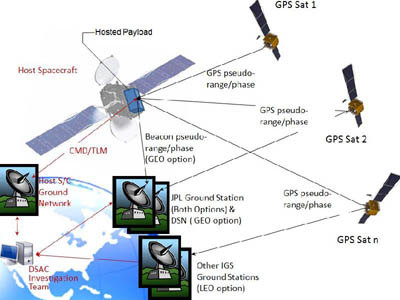NASA's lab representation of the Deep Space Atomic Clock. It has used a US quarter alongside the unit for size comparison. It said the clock is just under 0.2 cubic feet and weighs about 7 pounds. Image credit: NASA/JPL
NASA is pioneering a new deep space atomic clock so future spacecrafts will be able to calculate their own timing and navigation data in real time.
The space agency is calling the technology a Deep Space Atomic Clock, or DSAC, to revolutionise the way it carries out deep-space navigation.
Describing it as a “miniature mercury-ion atomic device” NASA said the DSAC team will fly as a payload on an Earth orbiter in a one-year experiment to validate its operability in space and its usefulness for one-way navigation.
Apparently the one-way navigation technology will build upon the current two-way system in which information is sent to Earth. This system currently requires a ground team to calculate timing and navigation and then transmit it back to a spacecraft.
NASA said the DSAC would provide real-time, on-board navigation so the space agency could carry out time-critical events, such as a planetary landing or a planetary fly-by when signal delays are too great for ground-based teams to interact with a spacecraft during such events.
“Adopting DSAC on future NASA missions will increase navigation and radio science data quantity by two to three times, improve data quality by up to 10 times and reduce mission costs by shifting toward a more flexible and extensible one-way radio navigation architecture,” said Todd Ely, principal investigator of the DSAC technology demonstration at NASA’s Jet Propulsion Laboratory (JPL), which is based in Pasadena, California.
Similar to GPS
NASA said the DSAC would build upon the existing space network and would not require any new antennas. It said the clock would deliver similar capabilities as GPS technology, except in deep-space navigation.
In the lab setting at JPL, NASA said the clock’s precision has been refined to permit drift of no more than one nanosecond in 10 days.
“A potential use for DSAC on a future mission would be in a follow-up to the Mars Reconnaissance Orbiter,” Ely said.

NASA said the planned Deep Space Atomic Clock mission would demonstrate the clock’s operability and performance while flown in the Earth’s orbit as a hosted payload. A GPS receiver and antenna will be connected with the clock in an integrated payload, NASA said. The clock will have, on average, a view of four satellites and will measure signals transmitted by each. Image credit: NASA/JPL
Atomic clocks are currently the most accurate timekeeping method known to humankind. They work by using the oscillating changes of atoms during different energy states.
The idea of using atomic transitions to measure time was first posited by the mathematical physicist and engineer Lord Kelvin back in 1879. Louis Essen built the first accurate atomic clock in 1955 at the National Physical Laboratory in the UK.